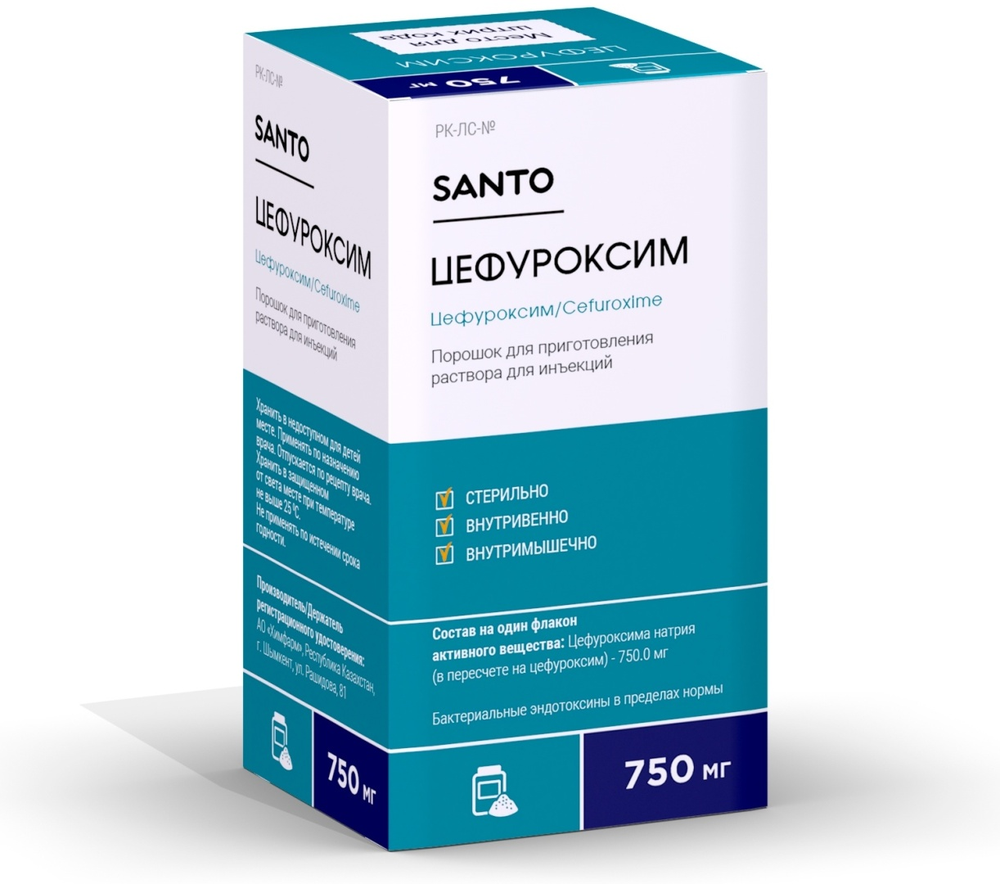

CEFUROKSIM 750 MG

Ask a doctor about a prescription for CEFUROKSIM 750 MG

How to use CEFUROKSIM 750 MG
INSTRUCTIONS for medical use of the medicinal product DAPIGRA (DAPIGRA)
DAPIGRA (DAPIGRA)
Composition:
active substance: dapoxetine;
1 film-coated tablet contains dapoxetine hydrochloride equivalent to dapoxetine 30 or 60 mg;
excipients: microcrystalline cellulose, lactose monohydrate, sodium croscarmellose, colloidal silicon dioxide, magnesium stearate, Opadry Grey 20G275000 coating;
Opadry Grey 20G275000 coating composition: hydroxypropylcellulose, macrogol 400, macrogol 6000, talc, titanium dioxide (E 171), black iron oxide (E 172), yellow iron oxide (E 172), red iron oxide (E 172).
Pharmaceutical form.
Film-coated tablets.
Main physical and chemical properties:
30 mg: round, grey film-coated tablets with a break line on one side and embossing "30" on the other side;
60 mg: round, grey film-coated tablets with a break line on one side and embossing "60" on the other side.
Pharmacotherapeutic group.
Other urologicals. ATC code G04B X14.
Pharmacological properties.
Pharmacodynamics.
Dapoxetine is a potent, selective inhibitor of serotonin reuptake (SSRI). Ejaculation in humans is primarily regulated by the sympathetic nervous system. Ejaculation is triggered by a spinal reflex center involving the brainstem, which is primarily influenced by a series of brain nuclei (medial preoptic and paraventricular nuclei).
The mechanism of action of dapoxetine in premature ejaculation is likely related to the inhibition of serotonin reuptake by neurons and the subsequent enhancement of the effects of neurotransmitters on pre- and postsynaptic receptors.
Clinical efficacy and safety.
The efficacy of dapoxetine in the treatment of premature ejaculation was established in 5 double-blind, placebo-controlled clinical trials, in which a total of 6081 patients were randomized. The patients' age was from 18 years. For 6 months prior to inclusion in the study, the majority of sexual acts in these patients were premature ejaculations. Premature ejaculation was defined according to the diagnostic criteria of DSM-IV (Diagnostic and Statistical Manual of Mental Disorders): a short time to ejaculation (intravaginal ejaculatory latency time [IELT]) of less than 2 minutes, measured using a stopwatch in 4 studies, weak control over ejaculation, and significant stress or difficulties in interpersonal relationships caused by this condition.
Patients with other types of sexual dysfunction, including erectile dysfunction, as well as patients taking other medications for premature ejaculation, were excluded from all studies.
The results of all randomized studies were comparable. Efficacy was observed after 12 weeks of treatment. One study included patients from both EU countries and other countries, and treatment lasted for 24 weeks. In the study, 1162 patients were randomized: 385 patients received placebo, 388 patients received dapoxetine 30 mg as needed, and 389 patients received dapoxetine 60 mg as needed. The mean and median IELT values at the end of the study are shown in Table 1, and the overall distribution of patients who achieved at least a certain level of median IELT at the end of the study is shown in Table 2. Other studies and a pooled analysis of data at 12 weeks showed similar results.
| Median IELT | Placebo, min | Dapoxetine 30 mg, min | Dapoxetine 60 mg, min |
| Median | 1.05 | 1.72 | 1.91 |
| Difference compared to placebo [95% CI] | 0.6 **[0.37; 0.72] | 0.9 **[0.66; 1.06] | |
| Mean value, calculated by the method of least squares | 1.7 | 2.9 | 3.3 |
| Difference compared to placebo [95% CI] | 1.2 **[0.59; 1.72] | 1.6 **[1.02; 2.16] |
* Background (baseline) value, carried over to patients for whom there are no baseline data.
** The difference was statistically significant (p ≤ 0.001).
| IELT (minutes) | Placebo % | Dapoxetine 30 mg, % | Dapoxetine 60 mg, % |
| ≥1.0 | 51.6 | 68.8 | 77.6 |
| ≥2.0 | 23.2 | 44.4 | 47.9 |
| ≥3.0 | 14.3 | 26.0 | 37.4 |
| ≥4.0 | 10.4 | 18.4 | 27.6 |
| ≥5.0 | 7.6 | 14.3 | 19.6 |
| ≥6.0 | 5.0 | 11.7 | 14.4 |
| ≥7.0 | 3.9 | 9.1 | 9.8 |
| ≥8.0 | 2.9 | 6.5 | 8.3 |
* Baseline value, carried over to patients with missing baseline data.
The magnitude of IELT prolongation was related to baseline IELT and was variable in individual patients: the clinical significance of the efficacy of dapoxetine treatment is demonstrated in the presented efficacy indicators and patient data analysis with a therapeutic effect.
A patient with a therapeutic effect was defined as one who had at least a 2-category increase in control over ejaculation plus at least a 1-category decrease in ejaculation disorders. A statistically significant therapeutic effect was observed in the majority of patients in each of the groups of patients taking dapoxetine compared to the placebo group at the end of the study: week 12 or 24. A higher percentage of patients with a therapeutic effect was observed in the group taking dapoxetine 30 mg (11.1-95% CI [7.24; 14.87]) and dapoxetine 60 mg (16.4-95% CI [13.01; 19.75]), compared to the placebo group at 12 weeks (pooled analysis).
The clinical significance of the effect of dapoxetine is illustrated by the example of the group for measuring the outcome of the Patient's Global Clinical Impression (CGIC), in which patients were asked to compare their premature ejaculation with the beginning of the study, with a gradation of responses: from "much better" to "much worse". At the end of the study (week 24), 28.4% (30 mg group) and 35.5% (60 mg group) of patients reported that their condition had improved or significantly improved compared to 14% of patients in the placebo group. Also, 53.4% and 65.6% of patients taking dapoxetine 30 mg and 60 mg, respectively, reported that their condition was at least slightly improved compared to 28.8% in the placebo group.
Pharmacokinetics.
Absorption. Dapoxetine is rapidly absorbed and reaches maximum plasma concentration (Cmax) approximately 1-2 hours after taking the tablet. The absolute bioavailability is 42% (range 15-76%), and in the range from 30 mg to 60 mg, Cmax and AUC (area under the concentration-time curve) increased proportionally with the dose. After multiple doses, the AUC values for dapoxetine and its active metabolite desmethyldapoxetine increased by approximately 50% compared to the AUC values after a single dose. Taking fatty food slightly decreased Cmax (by 10%) and slightly increased AUC of dapoxetine (by 12%), as well as slightly prolonged the time to reach Cmax of dapoxetine. These changes were not clinically significant. The drug Dapigra can be taken regardless of food intake.
Distribution. More than 99% of dapoxetine is bound to plasma proteins in vitro. The active metabolite desmethyldapoxetine is bound to proteins by 98.5%. The mean volume of distribution of dapoxetine at steady state is 162 liters.
Metabolism. According to in vitro studies, dapoxetine is metabolized by multiple enzyme systems in liver and kidney tissues (mainly CYP2D6, CYP3A4, and flavin-containing monooxygenase (FMO1)). Dapoxetine, after oral administration of 14C, is actively metabolized to form numerous metabolites involving mainly such biotransformation pathways: N-oxidation, N-demethylation, naphthyl hydroxylation, glucuronidation, and sulfation. There is evidence of a presystemic first-pass effect after oral administration.
Most of the substances circulating in plasma were intact dapoxetine and N-oxide dapoxetine. Data from binding and transport studies conducted in vitro showed that N-oxide dapoxetine is inactive. Additional metabolites, including desmethyldapoxetine and didesmethyldapoxetine, accounted for less than 3% of the total amount of substances in plasma bound to the drug. Data from binding studies conducted in vitro showed that desmethyldapoxetine and dapoxetine have the same efficacy, and the activity of didesmethyldapoxetine is approximately 50% of the activity of dapoxetine. The concentration of free desmethyldapoxetine (AUC and Cmax) is 50% and 23% of the concentration of free dapoxetine, respectively.
Excretion. Dapoxetine metabolites are excreted mainly in the urine as conjugates. The active substance was not detected in the urine in its unchanged form. After oral administration, the initial half-life of dapoxetine (pharmacokinetics) was approximately 1.5 hours, the plasma level was less than 5% of Cmax 24 hours after administration, and the terminal half-life is approximately 19 hours, as well as the terminal half-life of desmethyldapoxetine.
Pharmacokinetics in special patient groups.
The metabolite desmethyldapoxetine contributes to the pharmacological effect of dapoxetine, especially when the effect of desmethyldapoxetine increases. Below is an increase in the indicators of the active fraction in some patient groups. This is a summary of the free effect of dapoxetine and desmethyldapoxetine. Desmethyldapoxetine has the same potency as dapoxetine. The previous calculation assumes an even distribution of desmethyldapoxetine in the CNS, but it is not known if this will be the case.
Race. Analysis of clinical pharmacology of a single dose of 60 mg of dapoxetine did not show statistically significant differences in patients of different races.
Analysis of the clinical pharmacology study after a single dose of 60 mg of dapoxetine did not find a statistically significant difference between representatives of Latin Americans, as well as European, Negro, and Mongoloid races. Clinical studies comparing the pharmacokinetics of dapoxetine in Japanese and European patients found that Japanese patients had a higher level of dapoxetine in plasma (by 10-20%) (AUC and Cmax) due to lower body weight. A significant clinical effect, if the concentration is slightly higher, is not expected.
Patients of advanced age (65 years and older).
Analysis of pharmacology studies of a single dose of 60 mg of dapoxetine did not show significant differences in pharmacokinetic parameters (Cmax, AUCinf, Tmax) in healthy elderly men and healthy young men. Efficacy and safety were not established for patients in this age group.
Patients with renal impairment.
A clinical pharmacological study of a single dose of 60 mg of dapoxetine was conducted in patients with mild (creatinine clearance from 50 to 80 mL/min), moderate (creatinine clearance from 30 to <50 mL/min), and severe renal impairment (creatinine clearance <30 mL/min) and patients with normal renal function (creatinine clearance >80 mL/min). No trend towards an increase in AUC of dapoxetine was observed with decreasing renal function. AUC in patients with severe renal impairment was approximately twice as high as in patients with normal renal function, although there are limited data on patients with severe renal impairment. The pharmacokinetics of dapoxetine has not been evaluated in patients requiring hemodialysis.
Patients with hepatic impairment.
In patients with moderate hepatic impairment, the free Cmax of dapoxetine is decreased by 28%, and the free AUC remains unchanged. The free Cmax and AUC of the active fraction (the sum of the free effects of dapoxetine and desmethyldapoxetine) were reduced by 30% and 5%, respectively. In patients with moderate hepatic impairment, the free Cmax of dapoxetine is almost unchanged (decrease by 3%), and the free AUC increases by 66%. The free Cmax of the active fraction of dapoxetine and desmethyldapoxetine is almost unchanged, and the AUC is doubled.
In patients with severe hepatic impairment, the free Cmax of dapoxetine is decreased by 42%, but the free AUC is increased by approximately 223%. Cmax and AUC of the active fraction have similar changes.
CYP2D6 polymorphism.
A clinical pharmacological study of a single dose of 60 mg of dapoxetine showed that the plasma concentration in poor metabolizers of CYP2D6 was higher than in rapid metabolizers of CYP2D6 (approximately 31% higher for Cmax and 36% higher for AUCinf of dapoxetine, 98% higher for Cmax and 161% higher for AUCinf of desmethyldapoxetine). The active fraction of dapoxetine may be increased by approximately 46% for Cmax and approximately 90% for AUC. This increase may lead to a higher incidence of dose-dependent adverse effects, such as dose-dependent dependence. The safety of dapoxetine in poor metabolizers of CYP2D6 is of particular concern when used in combination with other medications that may inhibit the metabolism of dapoxetine, such as moderate and potent CYP3A4 inhibitors.
Clinical characteristics.
Indications.
Treatment of premature ejaculation in adult men aged 18 to 64 years.
Dapigra is recommended to be prescribed only to patients who meet the following criteria:
- intravaginal ejaculatory latency time (IELT) is less than 2 minutes;
- persistent or recurrent ejaculation after minimal sexual stimulation before, during, or shortly after vaginal penetration, which occurs earlier than desired by the patient;
- marked distress or interpersonal difficulty as a consequence of premature ejaculation;
- poor control over ejaculation;
- premature ejaculation has been present for the majority of attempted sexual intercourses in the past 6 months.
Dapigra should be taken as needed to treat premature ejaculation before anticipated sexual activity. The drug should not be prescribed to men who have not been diagnosed with premature ejaculation.
Contraindications.
- hypersensitivity to the active substance or to any of the excipients of the drug.
- heart failure (NYHA classes II-IV).
- conduction disorders, such as AV block or sick sinus syndrome.
- severe ischemic heart disease.
- severe valvular heart disease.
- history of syncope.
- history of mania or severe depression.
- concomitant use of monoamine oxidase inhibitors (MAOIs) or if it has been less than 14 days since their discontinuation. The use of Dapigra should be discontinued at least 7 days before starting therapy with MAOIs.
- concomitant use of thioridazine or within 14 days after its discontinuation. The use of Dapigra should be discontinued at least 7 days before starting therapy with thioridazine.
- concomitant use of SSRIs, SNRIs, tricyclic antidepressants (TCAs), or other medications/herbal products with serotonergic activity [e.g., L-tryptophan, triptans, tramadol, linezolid, lithium, and St. John's Wort (Hypericum perforatum)] or within 14 days after their discontinuation. These medications/herbal products should not be taken within 7 days after Dapigra discontinuation.
- concomitant use of potent CYP3A4 inhibitors, such as ketoconazole, itraconazole, ritonavir, saquinavir, telithromycin, nefazodone, nelfinavir, and atazanavir (see "Interactions with other medicinal products and other forms of interaction").
- moderate or severe hepatic impairment.
Interactions with other medicinal products and other forms of interaction.
Pharmacodynamic interactions.
Possible interaction with MAOIs.
When SSRIs are taken in combination with MAOIs, serious reactions have been reported, sometimes with a fatal outcome, including hyperthermia, rigidity, myoclonus, disturbances of the autonomic nervous system with possible rapid changes in vital signs, as well as changes in mental status, including pronounced excitement, which can transition into delirium and coma. Such reactions have also been reported in patients who have recently discontinued SSRI treatment and started MAOI treatment. There have been isolated cases with symptoms similar to malignant neuroleptic syndrome. Data on the combined use of SSRIs and MAOIs obtained in animal studies suggest that these medications may act synergistically, increasing blood pressure and causing excitement. Therefore, Dapigra should not be used in combination with MAOIs or within 14 days after their discontinuation. MAOIs should not be taken within 7 days after Dapigra discontinuation.
Possible interaction with thioridazine.
Thioridazine administration can cause QT interval prolongation, which is associated with the development of severe ventricular arrhythmias. Medications like Dapigra, which inhibit the CYP2D6 isoenzyme, are likely to inhibit thioridazine metabolism. The expected increase in thioridazine levels resulting from this is likely to cause more pronounced QT interval prolongation. Dapigra should not be used in combination with thioridazine or within 14 days after its discontinuation. Thioridazine should not be taken within 7 days after Dapigra discontinuation.
Medications/herbal products with serotonergic activity.
As with SSRIs, concomitant use with medications/herbal products that have serotonergic activity (including MAOIs, L-tryptophan, triptans, tramadol, linezolid, SSRIs, SNRIs, lithium, and St. John's Wort) may increase the frequency of serotonergic effects. Dapigra should not be used in combination with other SSRIs, MAOIs, or other medications/herbal products with serotonergic activity or within 14 days after their discontinuation. Similarly, these medications/herbal products should not be taken within 7 days after Dapigra discontinuation.
Central nervous system (CNS) active medications.
A systematic evaluation of the concomitant use of dapoxetine and CNS active medications (such as antiepileptics, antidepressants, antipsychotics, anxiolytics, sedatives) in patients with premature ejaculation has not been conducted. Therefore, caution is advised when concomitantly prescribing Dapigra and these medications.
Pharmacokinetic interactions.
Influence of other medications on the pharmacokinetics of dapoxetine when used concomitantly.
In vitro studies of human liver and kidney tissues, as well as intestinal microsomes, have shown that dapoxetine is metabolized primarily by CYP2D6, CYP3A4, and FMO1. Therefore, inhibitors of these enzymes may decrease the clearance of dapoxetine.
CYP3A4 inhibitors.
Potent CYP3A4 inhibitors. The administration of ketoconazole (200 mg twice daily for 7 days) increases the Cmax and AUCinf of dapoxetine (single dose of 60 mg) by 35% and 99%, respectively. Regarding the distribution of both free dapoxetine and desmethyldapoxetine, the Cmax of the active fraction may increase by approximately 25%, and the AUC of the active fraction may increase by 2 times when using potent CYP3A4 inhibitors.
The increase in Cmax and AUC of the active fraction may be significantly increased in patients with impaired CYP2D6 enzyme function, particularly in poor metabolizers of CYP2D6, or when used concomitantly with potent CYP2D6 inhibitors.
Therefore, concomitant use of Dapigra and potent CYP3A4 inhibitors, such as ketoconazole, itraconazole, ritonavir, saquinavir, telithromycin, nefazodone, nelfinavir, and atazanavir, is contraindicated.
CYP3A4 inhibitors with moderate activity.
Concomitant use of dapoxetine and CYP3A4 inhibitors with moderate activity (e.g., erythromycin, clarithromycin, fluconazole, amprenavir, fosamprenavir, aprepitant, verapamil, diltiazem) may also lead to a significant increase in exposure to dapoxetine and desmethyldapoxetine, especially in poor metabolizers of CYP2D6. When used concomitantly with any of these medications, the maximum dose of dapoxetine should be 30 mg.
This applies to all patients, except those who have been identified as active metabolizers of CYP2D6 through geno- or phenotyping. Patients who are active metabolizers of CYP2D6 are recommended to have a maximum dose of dapoxetine of 30 mg when used concomitantly with a potent CYP3A4 inhibitor. They should exercise caution when concomitantly using dapoxetine at a dose of 60 mg and a CYP3A4 inhibitor with moderate activity.
Potent CYP2D6 inhibitors.
Cmax and AUCinf of dapoxetine (single dose of 60 mg) increase by 50% and 88%, respectively, in the presence of fluoxetine (60 mg/day for 7 days). Regarding the distribution of both free dapoxetine and desmethyldapoxetine, the Cmax of the active fraction may increase by approximately 50%, and the AUC of the active fraction may increase by 2 times when using potent CYP2D6 inhibitors. This increase in Cmax and AUC of the active fraction is similar to that expected in poor metabolizers of CYP2D6 and may lead to an increased incidence of dose-dependent adverse effects.
PDE5 inhibitors.
Patients taking PDE5 inhibitors should not take Dapigra due to the potential for decreased orthostatic tolerance. An evaluation of the pharmacokinetics of dapoxetine (60 mg) in combination with tadalafil (20 mg) and sildenafil (100 mg) was conducted in a crossover study with single-dose administration. Tadalafil did not affect the pharmacokinetics of dapoxetine. Sildenafil caused slight changes in the pharmacokinetics of dapoxetine (increase in AUCinf by 22% and increase in Cmax by 4%), which are likely to be clinically insignificant.
Concomitant use of Dapigra and PDE5 inhibitors may cause orthostatic hypotension. The efficacy and safety of dapoxetine for patients with premature ejaculation and erectile dysfunction who are taking Dapigra and PDE5 inhibitors concomitantly have not been established.
Influence of dapoxetine on the pharmacokinetics of concomitantly used medications.
Tamsulosin.
Concomitant administration of a single dose or multiple doses of 30 mg or 60 mg of Dapigra to patients taking tamsulosin (0.4 mg/day) did not affect the pharmacokinetics of the latter. Concomitant use of dapoxetine and tamsulosin did not cause changes in the orthostatic profile and orthostatic effects compared to tamsulosin alone or tamsulosin with dapoxetine at a dose of 30 or 60 mg.
However, when prescribing Dapigra to patients taking alpha-adrenergic receptor antagonists, caution should be exercised due to the potential for decreased orthostatic tolerance.
Medications metabolized by CYP2D6.
Administration of dapoxetine in multiple doses (60 mg/day for 6 days) with subsequent single-dose administration of 50 mg of desipramine resulted in an increase in the mean Cmax and AUCinf of desipramine by 11% and 19%, respectively, compared to desipramine alone. Dapoxetine may cause a similar increase in plasma concentrations of other medications metabolized by CYP2D6. This is likely to be clinically insignificant.
Medications metabolized by CYP3A4.
Multiple-dose administration of dapoxetine (60 mg/day for 6 days) resulted in a decrease in the AUCinf of midazolam (single dose of 8 mg) by approximately 20% (range 60 to +18%). This effect on midazolam is likely to be clinically insignificant for most patients. An increase in CYP3A4 activity may be clinically significant in some patients who are concomitantly taking a medication that is primarily metabolized by CYP3A4 and has a narrow therapeutic index.
Medications metabolized by CYP2C19.
Administration of dapoxetine in multiple doses (60 mg/day for 6 days) did not inhibit the metabolism of omeprazole (single dose of 40 mg). Dapoxetine is likely to have no effect on the pharmacokinetics of other CYP2C19 substrates.
Medications metabolized by CYP2C9.
Administration of dapoxetine in multiple doses (60 mg/day for 6 days) did not affect the pharmacokinetics or pharmacodynamics of glibenclamide (single dose of 5 mg). Dapoxetine is likely to have no effect on the pharmacokinetics of other CYP2C9 substrates.
Warfarin and medications affecting blood coagulation and/or platelet function.
There are no data on the evaluation of the effect of regular warfarin administration and dapoxetine. Therefore, caution is advised when using dapoxetine in patients who are constantly taking warfarin. In a pharmacokinetic study, dapoxetine (60 mg/day for 6 days) did not affect the pharmacokinetics or pharmacodynamics of warfarin (PT or INR) after a single dose of 25 mg.
Bleeding has been reported with the use of SSRIs.
Alcohol.
Concomitant administration of alcohol (single dose of 0.5 g/kg) did not affect the pharmacokinetics of dapoxetine (single dose of 60 mg); however, dapoxetine in combination with alcohol enhances somnolence and significantly impairs alertness. Pharmacodynamic measurements of cognitive function disturbances (digital attention test, symbol substitution test) also showed an additive effect when dapoxetine and alcohol were used concomitantly. Concomitant use of alcohol and dapoxetine increases the likelihood of developing or worsening adverse effects, such as dizziness, somnolence, slowed reflexes, or impaired ability to properly assess the situation. The combination of alcohol and dapoxetine may enhance the effects associated with alcohol consumption and may increase the likelihood of developing a neurocardiogenic undesirable event, such as syncope, thereby increasing the risk of accidental injury; therefore, patients should be advised not to consume alcohol during treatment with dapoxetine.
Special warnings and precautions for use.
General recommendations.
Dapigra should only be prescribed to men with premature ejaculation (see "Indications"). The drug should not be prescribed to men who have not been diagnosed with premature ejaculation. The safety and efficacy of dapoxetine have not been established in men without premature ejaculation.
Other forms of sexual dysfunction.
Before starting treatment, patients with other forms of sexual dysfunction, including erectile dysfunction, should be thoroughly evaluated by a physician. Dapigra should not be used in men with erectile dysfunction who are taking PDE5 inhibitors.
Orthostatic hypotension (hypotension).
A thorough medical examination by a physician is necessary before starting treatment, including a history of orthostatic episodes. An orthostatic test should be performed before starting therapy (blood pressure and pulse rate, in the supine position, on the back, and standing). If there is a documented history or suspected orthostatic reaction, the use of Dapigra should be avoided.
Orthostatic hypotension has been reported in clinical trials. The physician should advise the patient in advance that if prodromal symptoms such as dizziness occur soon after standing up, the patient should immediately lie down with their head lower than the rest of their body or sit with their head between their knees until the symptoms pass. The patient should not quickly get up after prolonged sitting or lying down.
Suicidal thoughts/self-harm.
Antidepressants, including SSRIs, increase the risk of suicidal thoughts and suicidal behavior in children and adolescents with major depressive and other psychiatric disorders compared to placebo in short-term studies. Short-term studies do not show an increased risk of suicidal tendencies in adults aged 24 and older compared to placebo. In clinical trials of dapoxetine for the treatment of premature ejaculation, there was no clear evidence of suicidal tendencies during treatment with the drug, as assessed by the Columbia Classification Algorithm for Suicide Assessment (C-CASA), the Montgomery-Asberg Depression Rating Scale, or the Beck Depression Inventory-II.
Loss of consciousness.
Patients should be warned to avoid situations that may lead to injury, including driving a car or operating hazardous machinery, as loss of consciousness or prodromal symptoms such as dizziness or presyncope may occur.
Prodromal symptoms, such as nausea, dizziness/presyncope, and increased sweating, have been reported, which occur more frequently in patients taking dapoxetine compared to placebo.
In clinical trials, cases of loss of consciousness have been characterized by loss of consciousness with bradycardia or sinus node arrest. These cases have been observed in patients who have undergone Holter ECG monitoring and are considered to be vasovagal in etiology, but most cases have been reported within the first 3 hours after taking the first dose of the drug or are related to study procedures in a clinical setting (e.g., blood sampling and orthostatic procedures, blood pressure measurement). Possible prodromal symptoms, such as nausea, dizziness, presyncope, feeling of palpitations, weakness, confusion, and increased sweating, usually occur within the first 3 hours after dosing, often preceding loss of consciousness. Patients should be informed about the likelihood of loss of consciousness at any time with or without prodromal symptoms during Dapigra treatment. The physician should advise patients on the importance of maintaining adequate hydration and recognizing prodromal symptoms to minimize the risk of serious injuries associated with falls due to loss of consciousness. If a patient experiences prodromal symptoms, they should immediately lie down with their head lower than the rest of their body or sit with their head between their knees until the symptoms pass.
Patients with cardiovascular risk factors.
Patients with cardiovascular diseases were excluded from phase 3 clinical trials. The risk of adverse cardiovascular outcomes from loss of consciousness (cardiac syncope and syncope from other causes) is increased in patients with underlying structural cardiovascular diseases (e.g., documented outflow obstruction, valvular heart disease, carotid stenosis, and ischemic heart disease). There is insufficient data to determine whether this increased risk applies to vasovagal syncope in patients with cardiovascular diseases.
Use with recreational substances.
Patients should not be advised to use Dapigra in combination with recreational substances.
Recreational substances (drugs) with serotonergic activity, such as ketamine, methylenedioxymethamphetamine (MDMA), and lysergic acid diethylamide (LSD), may lead to potentially serious reactions when used with Dapigra. These reactions include, but are not limited to, arrhythmias, hyperthermia, and serotonin syndrome. The use of Dapigra with recreational substances that have sedative properties, such as narcotics and benzodiazepines, may increase somnolence and dizziness.
The combination of alcohol and dapoxetine may enhance alcohol-related neurocognitive effects and may lead to an increased risk of neurocardiogenic undesirable events, such as loss of consciousness, thereby increasing the risk of accidental injury; therefore, patients should be advised not to consume alcohol during treatment with dapoxetine.
Dapigra should be prescribed with caution to patients taking medications with vasodilatory properties (e.g., alpha-adrenergic receptor antagonists and nitrates) due to the potential for decreased orthostatic tolerance.
Manic syndrome.
Dapigra should not be prescribed to patients with a history of manic syndrome/hypomania or bipolar affective disorder. The use of the drug should be discontinued if symptoms of these disorders appear.
Epileptic seizure.
Due to the properties of SSRIs, which can lower the seizure threshold in any patient, the use of Dapigra should be discontinued if an epileptic seizure occurs. Patients with unstable epilepsy should avoid using Dapigra. Patients with controlled epilepsy should be closely monitored during treatment with Dapigra.
Depression and/or mental disorders.
Men with primary symptoms and signs of depression should be evaluated before starting treatment to exclude undiagnosed depressive disorders. Combination treatment with Dapigra and antidepressants, including SSRIs and SNRIs, is contraindicated. It is not recommended to discontinue treatment of persistent depression or anxiety to initiate Dapigra treatment for premature ejaculation. The drug is not recommended for the treatment of mental disorders and should not be used in men with disorders such as schizophrenia or those suffering from hypochondria, as worsening of symptoms related to depression cannot be excluded. This may be the result of the underlying mental disorder or a consequence of therapy with the drug. Physicians should encourage patients to report any disturbing thoughts or feelings at any time. If signs and symptoms of depression occur during treatment, the use of the drug should be discontinued.
Bleeding.
There have been reports of bleeding disorders with the use of SSRIs. Caution is advised when using the drug, especially concomitantly with medications that affect platelet function (e.g., atypical antipsychotics and phenothiazines, acetylsalicylic acid, nonsteroidal anti-inflammatory drugs, antiplatelet agents), or with anticoagulants (e.g., warfarin), as well as in the presence of a history of bleeding or coagulation disorders.
Renal impairment.
Dapigra is not recommended for use in patients with severe renal impairment. The drug should be used with caution in patients with mild or moderate renal impairment.
Withdrawal syndrome.
The sudden discontinuation of long-term SSRI treatment for chronic depressive disorders leads to symptoms such as dysphoric disorder, irritability, agitation, dizziness, sensory disturbances (e.g., paresthesia, such as electric shock-like sensations), anxiety, confusion, headache, fatigue, emotional lability, insomnia, and hypomania.
The results of the safety study of Dapigra showed more frequent symptoms of mild or moderate insomnia and dizziness in patients who switched to placebo after 62 days of daily Dapigra treatment.
Shelf life.
3 years.
Storage conditions.
Store at a temperature not exceeding 25 °C in the original packaging.
Keep out of the reach of children.
Packaging.
3 tablets in a blister pack. 1 or 2 blister packs in a carton box.
Release category.
Prescription only.
Manufacturer.
Nobel Ilac San. ve Tic. A.S.
Manufacturer's location and address.
Sancaktepe District, Eskı Akçakoca Street, No: 299, 81100 Düzce, Turkey.
- Country of registration
- Active substance
- Prescription requiredYes
- Manufacturer
- This information is for reference only and does not constitute medical advice. Always consult a licensed doctor before taking any medication. Oladoctor is not responsible for medical decisions based on this content.
- Alternatives to CEFUROKSIM 750 MGDosage form: powder, 0.750 g No. 10, No. 100Active substance: cefuroximeManufacturer: Медокемі Лімітед (виробництво за повним циклом)Prescription requiredDosage form: powder, 1.5 g No. 10Active substance: cefuroximeManufacturer: Медокемі Лімітед (виробництво за повним циклом)Prescription requiredDosage form: tablets, 250 mgActive substance: cefuroximeManufacturer: Медокемі ЛімітедPrescription required
Alternatives to CEFUROKSIM 750 MG in other countries
The best alternatives with the same active ingredient and therapeutic effect.
Alternative to CEFUROKSIM 750 MG in Spain
Alternative to CEFUROKSIM 750 MG in Poland
Online doctors for CEFUROKSIM 750 MG
Discuss dosage, side effects, interactions, contraindications, and prescription renewal for CEFUROKSIM 750 MG – subject to medical assessment and local rules.














